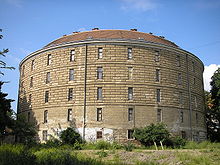- Narrenturm (hospital)
-
The Narrenturm (Fool's Tower) in Vienna is continental Europe's oldest building for the accommodation of mental patients.[1] Built in 1784, it is next to the site of the old Vienna General Hospital (today a university campus), and is now home to the Federal Pathologic-Anatomical Museum Vienna (German: Pathologisch-anatomisches Bundesmuseum Wien).
Contents
The building
The Narrenturm was constructed in 1784, under Emperor Joseph II, by Isidore Canevale. It consisted of a five-storey, fortress-like circular building with 28 rooms and a ring of slit windows, plus a central chamber aligned north-south. There were in total 139 individual cells for the inmates. The building of the Narrenturm was prompted by the discovery of underground dungeons used by the Capuchin monks of Vienna for housing their mentally ill brethren; another factor was that Joseph II had learned about similar institutions in France during his travels there. The construction of the Narrenturm points to a new attitude towards the mentally ill – they began to be distinguished from the rest of society, and not simply classified among the general category of "the poor".[2]
Each cell had strong, barred doors as well as chains for shackling unrestrained inmates.[1] With its barracks-like appearance, the tower was a visible expression of the segregation, stigmatisation and criminalisation of socially deviant forms of behaviour.
By the late 1790s the tower had already been made fully obsolete by innovations in the treatment of mental patients. Despite appearances, the Narrenturm was not an implementation of Jeremy Bentham's hypothetical panopticon, as the cells could not be monitored from a central post.
The tower's round shape is the source of the Viennese slang word Gugelhupf (a type of round cake) for mental asylums and psychiatric clinics.[1]
When it was first built, the Narrenturm had a lightning rod or "lightning catcher" installed on the roof ridge. Two of the supporting fixtures can still be seen in the inner chamber. Václav Prokop Diviš, a clergyman in Přímětice near Znojmo, created the world's first earthed conductor in his garden in 1754; it is sometimes claimed that he did this independently of Benjamin Franklin, who invented the lightning rod in 1753.[3] At this time some people believed electricity to have health benefits – however, it is not known whether the lightning rod in the Narrenturm, whose remnants are probably the oldest surviving pieces of such a device in the world, was used in the treatment of patients.
The museum
The tower is currently home to the Federal Pathologic-Anatomical Museum, founded by Emperor Francis II in 1796 as the "Museum of the Pathologic-Anatomical Institute". It has been a national museum (Bundesmuseum) since 1974.
Electro-Pathological Museum
Parts of the former Electro-Pathological Museum, founded in 1936 by Stefan Jellinek, are housed here. Jellinek was forced to leave the country in 1939, but regained his old collection after the war. A new exhibition was created after Jellinek's death in 1968 by his colleague Franz Maresch. In the 1980s the Technisches Museum Wien took over a large part of the collection, while its preserved human and animal exhibits were transferred to the Pathologic-Anatomical Museum.[4]
Notes
- ^ a b c Narrenturm: Erstes Tollhaus am Platz Ulrike Abel-Wanek, Pharmazeutische Zeitung, 2007. Retrieved 14 September 2010. (German)
- ^ Geschichte der Armut und des Bettels in der Neuzeit Martin Scheutz, University of Vienna lecture. (German)
- ^ Hujer, Karel (December 1952). "Father Procopius Diviš — The European Franklin". Isis 43 (4): 351–357. doi:10.1086/348159. ISSN 0021-1753. http://www.jstor.org/stable/227388. (English)
- ^ Eröffnung der Elektro- Pathologischen Sammlung im Wiener Narrenturm Kultur-Online, 12 February 2010. Retrieved 16 August 2010. (German)
- This article incorporates information from this version of the equivalent article on the German Wikipedia.
Further reading
- Patzak, Beatrix. "Faszination und Ekel" Das Pathologisch-anatomische Bundesmuseum im Wiener Narrenturm. Stocker. ISBN 978-3-85365-235-0. http://www.wienerzeitung.at/DesktopDefault.aspx?TabID=4982&Alias=wienerjournal&cob=423286. (German)
- Stohl, Alfred (2000). Der Narrenturm oder Die dunkle Seite der Wissenschaft. Vienna: Böhlau. ISBN 3-20599207-5. http://www.evolver.at/print/Alfred_Stohl_Der_Narrenturm/. (German)
- Hausner, Ernst (1998). Das pathologisch-anatomische Bundesmuseum im Narrenturm des alten Allgemeinen Krankenhauses in Wien. Vienna: Edition Hausner. ISBN 978-3-901141-27-0. (German)
- Roth, Gerhard (1993). Die Archive des Schweigens. 7. Frankfurt am Main: Fischer Taschenbuch. pp. 110–130. ISBN 3-596-11407-1. (German)
External links
- Pathologic-Anatomical Museum, including history of the museum (German)
See also
Coordinates: 48°13′07″N 16°21′12″E / 48.21861°N 16.35333°E
Categories:- Museums in Vienna
- Buildings and structures in Vienna
- Museums established in 1971
Wikimedia Foundation. 2010.


